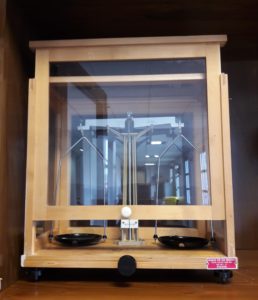
IT – La bilancia analitica a bracci uguali è uno strumento di misura della massa, con un elevato grado di precisione. E’ racchiusa in un recipiente trasparente (apribile), in modo che la polvere non possa entrare e le correnti d’aria non falsino la misura. Il termine bilancia deriva dal latino “bilanx” che significa “a due piatti”. Essa è uno degli strumenti più antichi inventati dall’uomo: se ne conservano esemplari databili al V sec. a.C. Il suo funzionamento è basato sul principio della leva: è costituita da un giogo che può oscillare attorno ad un fulcro, recante alle estremità due piatti. La pesata avviene mediante confronto tra pesi campione di massa nota e l’oggetto di massa ignota. Gli spostamenti dalla posizione di equilibrio vengono segnalati dall’indice su una scala graduata.
GB – Analytical weight scale with equal arms – The analytical weight scale (or “balances”) with equal arms is a mass measurement instrument, with a high degree of precision. It is enclosed in a transparent container (which can be opened), so that dust cannot enter, and air currents do not distort the measurement. The term weight “balances” comes from the Latin “bilanx” which means “two plates”. It is one of the most ancient instruments invented by man, with examples dating back to the 5th millennium B.C. Its operation can be traced back to the principle of leverage: it consists of a yoke that can swing around a fulcrum, bearing two plates at the ends. Weighing is performed by comparing known mass sample weights with the object of unknown mass. The displacements from the equilibrium position are indicated by the index on a graduated scale.